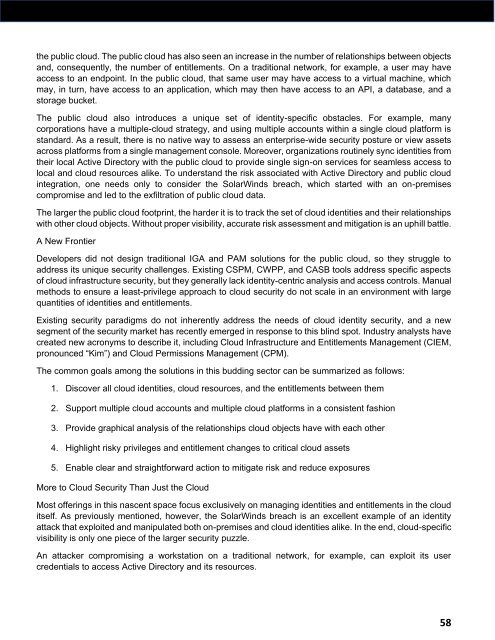The Black Unicorn Report for 2021
In this Black Unicorn Report for 2021, we’ve taken a few unique cybersecurity lenses to view the market and predict the future. Note that post COVID-19, the world has turned upside down and it’s accelerated telecommuting and cloud-based apps (SaaS) expansion, moving us from 3-4% home workforce to over 51% and growing. Thus, the major attack vectors have shifted to the cloud and weaker home-computing hygiene. This has opened doors for increased revenues and visibility among those players who secure the cloud, SaaS apps and deal with weak, remote, exposed endpoints. Learn about the winners and finalists in seven key categories and get one step ahead of the next threat with their help.
In this Black Unicorn Report for 2021, we’ve taken a few unique cybersecurity lenses to view the market and predict the future. Note that post COVID-19, the world has turned upside down and it’s accelerated telecommuting and cloud-based apps (SaaS) expansion, moving us from 3-4% home workforce to over 51% and growing. Thus, the major attack vectors have shifted to the cloud and weaker home-computing hygiene. This has opened doors for increased revenues and visibility among those players who secure the cloud, SaaS apps and deal with weak, remote, exposed endpoints. Learn about the winners and finalists in seven key categories and get one step ahead of the next threat with their help.
Create successful ePaper yourself
Turn your PDF publications into a flip-book with our unique Google optimized e-Paper software.
the public cloud. <strong>The</strong> public cloud has also seen an increase in the number of relationships between objects<br />
and, consequently, the number of entitlements. On a traditional network, <strong>for</strong> example, a user may have<br />
access to an endpoint. In the public cloud, that same user may have access to a virtual machine, which<br />
may, in turn, have access to an application, which may then have access to an API, a database, and a<br />
storage bucket.<br />
<strong>The</strong> public cloud also introduces a unique set of identity-specific obstacles. For example, many<br />
corporations have a multiple-cloud strategy, and using multiple accounts within a single cloud plat<strong>for</strong>m is<br />
standard. As a result, there is no native way to assess an enterprise-wide security posture or view assets<br />
across plat<strong>for</strong>ms from a single management console. Moreover, organizations routinely sync identities from<br />
their local Active Directory with the public cloud to provide single sign-on services <strong>for</strong> seamless access to<br />
local and cloud resources alike. To understand the risk associated with Active Directory and public cloud<br />
integration, one needs only to consider the SolarWinds breach, which started with an on-premises<br />
compromise and led to the exfiltration of public cloud data.<br />
<strong>The</strong> larger the public cloud footprint, the harder it is to track the set of cloud identities and their relationships<br />
with other cloud objects. Without proper visibility, accurate risk assessment and mitigation is an uphill battle.<br />
A New Frontier<br />
Developers did not design traditional IGA and PAM solutions <strong>for</strong> the public cloud, so they struggle to<br />
address its unique security challenges. Existing CSPM, CWPP, and CASB tools address specific aspects<br />
of cloud infrastructure security, but they generally lack identity-centric analysis and access controls. Manual<br />
methods to ensure a least-privilege approach to cloud security do not scale in an environment with large<br />
quantities of identities and entitlements.<br />
Existing security paradigms do not inherently address the needs of cloud identity security, and a new<br />
segment of the security market has recently emerged in response to this blind spot. Industry analysts have<br />
created new acronyms to describe it, including Cloud Infrastructure and Entitlements Management (CIEM,<br />
pronounced “Kim”) and Cloud Permissions Management (CPM).<br />
<strong>The</strong> common goals among the solutions in this budding sector can be summarized as follows:<br />
1. Discover all cloud identities, cloud resources, and the entitlements between them<br />
2. Support multiple cloud accounts and multiple cloud plat<strong>for</strong>ms in a consistent fashion<br />
3. Provide graphical analysis of the relationships cloud objects have with each other<br />
4. Highlight risky privileges and entitlement changes to critical cloud assets<br />
5. Enable clear and straight<strong>for</strong>ward action to mitigate risk and reduce exposures<br />
More to Cloud Security Than Just the Cloud<br />
Most offerings in this nascent space focus exclusively on managing identities and entitlements in the cloud<br />
itself. As previously mentioned, however, the SolarWinds breach is an excellent example of an identity<br />
attack that exploited and manipulated both on-premises and cloud identities alike. In the end, cloud-specific<br />
visibility is only one piece of the larger security puzzle.<br />
An attacker compromising a workstation on a traditional network, <strong>for</strong> example, can exploit its user<br />
credentials to access Active Directory and its resources.<br />
58


















